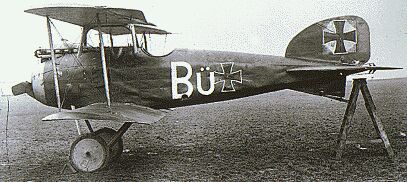
Albatros D.I, by Albatros Flugzeugwerke
Main role: Fighter
Engine: either a 110 kW (150 hp) Benz Bz.III or a 120 kW (160 hp) Mercedes D.III six-cylinder water cooled inline engine
Armament: 1 × forward-firing synchronized 7.92 mm (0.312 in) lMG 08 machine gun
The D.I was designed by Robert Thelen, R. Schubert and Gnädig, as an answer to the latest Allied fighters, such as the Nieuport 11 Bébé and the Airco D.H.2, which had proved superior to the Fokker Eindecker and other early German fighters, and established a general Allied air superiority. It was ordered in June 1916 and introduced into squadron service that August.
The D.I had a semi-monocoque plywood fuselage, consisting of a single-layered outer shell, supported by a minimal internal structure. This was lighter and stronger than the fabric-skinned box-type fuselage then in common use, as well being easier to give an aerodynamically clean shape. At the same time its panelled-plywood skinning, done with mostly four-sided panels of thin plywood over the entire minimal fuselage structure, was less labour-intensive (and therefore less costly to manufacture) than a “true” monocoque structure.The Albatros D.I was powered by either a 110 kW (150 hp) Benz Bz.III or a 120 kW (160 hp) Mercedes D.III six-cylinder water cooled inline engine. The additional power of the Mercedes (Daimler) engine enabled twin fixed Spandau machine-guns to be fitted without any loss in performance.
The D.I had a relatively high wing loading for its time, and was not particularly manoeuvrable. This was compensated by its superior speed and firepower and it quickly proved the best all-round fighter available.
Source: Wikipedia
Span: 8.5 m (27 ft 11 in)
Length: 7.4 m (24 ft 3 in)
Height: 2.95 m (9 ft 8 in)
Wing surface: 22.9 m2 (246 sq ft)
Empty weight: 647 kg (1,426 lb)
Max. weight: 898 kg (1,980 lb)
Cruise speed:
Max. speed: 175 km/h (109 mph)
Ceiling: 5,000 m (16,000 ft)
Endurance: 1.5 hours
Climb rate: 2.8 m/s (550 ft/min)




